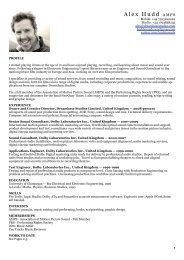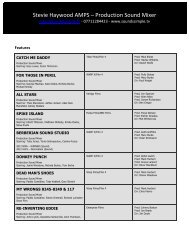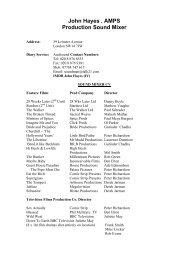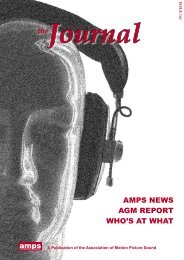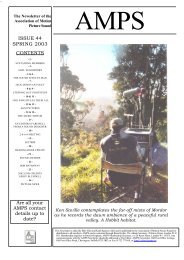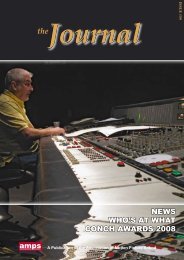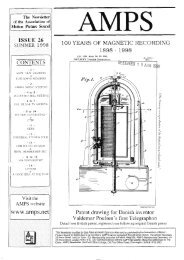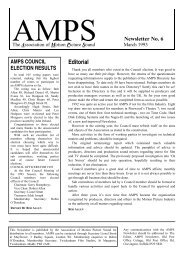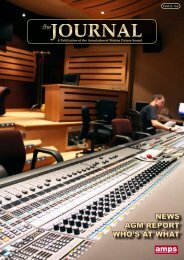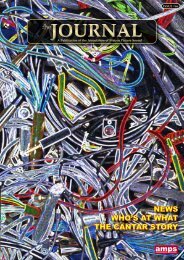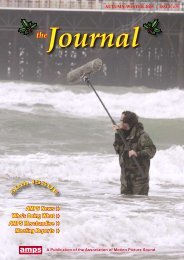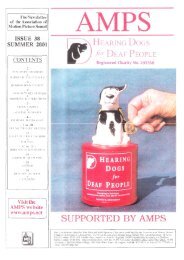Summer 2000 - The Association of Motion Picture Sound
Summer 2000 - The Association of Motion Picture Sound
Summer 2000 - The Association of Motion Picture Sound
You also want an ePaper? Increase the reach of your titles
YUMPU automatically turns print PDFs into web optimized ePapers that Google loves.
t'-<br />
<strong>The</strong> Newsletter<br />
<strong>of</strong> the <strong>Association</strong> <strong>of</strong><br />
<strong>Motion</strong> <strong>Picture</strong> <strong>Sound</strong><br />
TSSUE 34<br />
SUMMER 2OOO<br />
CONTENTS<br />
-2-<br />
St S l',\l\l\(l \ ll :\ llll rltli<br />
-3to4l)l{(<br />
)'l ( )()l.S l)l i\ l( ) ltlil)Ol{l'<br />
-5to6-<br />
It\'(l(tl'lr S()l Nl) l()l{t \l<br />
-'t -<br />
\l:\\/S \()l'lrS<br />
-8to9-<br />
'lltl r\,\(;l{.\<br />
\ l'l it{SON,\l . l'ltlllt 'l l r<br />
I.l il"l'lN( ; ()l ;l; s'l'l i,\\ t<br />
- l2 to l3 -<br />
\lr\\' l;ll.\l (lOt \(lll.<br />
l( )Ni\,ll ls l'ult,\(ir. N( i<br />
\ \'iloN,\1. sot \-l) \ltcl llYIi<br />
sili..rot IN (il1il.(it I)<br />
I rt)\\r.\RIi Iit ItNl)s<br />
- 15 -<br />
)lltN (ll .,\l{l{i ()lll'l't ,\lt\<br />
- 16-<br />
BOIt \t.t .ttN's<br />
l;.\l'l'l 1l ;l L I ;lilliNl)s<br />
Visit the<br />
AMPS website<br />
wwlv.amps.net<br />
H<br />
AMPS<br />
TRIBIJTE TO THE NAGRA<br />
..dro*sdF$W'"<br />
ai:.<br />
*i :. ,--&s-rir,. ....&rri#<br />
&.<br />
\-<br />
!t<br />
Nagra 4.2 in Doco Mode<br />
:'r&'H$*|e{...'r;<br />
g<br />
-*",ru<br />
'l his \crvslctter is cditcd b)'lJob.\llcn and l(cith Spcnccr \llen and is published by thc,\ssr-:ciation ol'trfotion ])icturc<br />
<strong>Sound</strong> li)l distribution [o all nrcmtrcts. ,\\'ll)S can be contactcd through l]rian I lickin, 'fhe ,\dnrin Secrcta|y. 2ti linox<br />
Strccl,Lontlon Wlllll;S.\.lenrhcrshipcnqtriricsloI):rtrickIIcigh:rnr,,\\[)S\lcmbcrshipScr:retiLry,c'o]8 l(rrox<br />
Strcct, l-ondon Wlll ll;S. ,\nvconrmurticationsrviththc,\\,lPSNervslcttershouldbeaddressedto<strong>The</strong>llditor',..\\.lPS<br />
\crvslcttcr,()ldPostOllicc(lottirgc,Oldll)stOl-liccRoad,Ohu'rngton,Sul'folk IP29-5RD,or Fax0l732 7791(rtl,tr'<br />
I inrail : editor(rlranrps.nct<br />
:i
Dear Mernbers<br />
Please accept our apologies<br />
enjoy reading wltile basking in for not getting this <strong>Summer</strong> issue to you in time to<br />
tlrc sun on the beaclt or by tlrc pool<br />
Keitlt & Bob<br />
AMPS SUSTAINING MEMBERS<br />
AKAI PROFESSIONAL<br />
wrvw.akaipro.com<br />
AMS NEVE<br />
ww!v.ams_ ne\/e. coln<br />
ANVIL POST PRODUCTION<br />
AUDIO DEVELOPMENTS<br />
u'n,w.audio.co.uk<br />
AUDIO Ltd<br />
wwn,.audioltd.com<br />
DE LANE LEA<br />
SOUND CENTRE<br />
DOLBY<br />
rvww.dolby.com<br />
DSP Ltd<br />
www.teddington.co.uk<br />
DTS<br />
wwlv. dtsonli ne.com<br />
FELTECH ELECTRONICS<br />
www.fehech.co.uk<br />
FITZROVIA POST<br />
PRODUCTION<br />
HARRISON<br />
wwrv.glw.com<br />
NAGRA<br />
www.nagra"coll-I<br />
2<br />
PINEWOOD STUDIOS<br />
RICHMOND FILM SERVICBS<br />
RPS DATA PRODUCTS (UK)<br />
lvwrv. rpsdataproducf s.co. uk<br />
RYCOTE<br />
\\,\\.\1'. rycolc.com<br />
SEI\NHEISER<br />
rvwrv. sennhei ser. co. uk<br />
SOTID STATE LOGIC<br />
n, rvw. sol id-state-l osi c. corr<br />
SONY BROADCAST &<br />
PROFESSIONAL UK<br />
\vww. pro. sony-eut ope.coln<br />
SONY CINEMA PRODUCTS<br />
wwrv.sdds.com<br />
SOUND DESIGNERS<br />
www. sound-desi sners.co. uk<br />
TECHNICOLOR<br />
wrvw" technicolor.com<br />
TELEFILM VIDEO SERVICES<br />
www.teletilm"co.uk<br />
TWICKENIIAM FILM STUDIOS<br />
wr'vw. twickenhamfi lmstudios. com
PRO TOOLS DEMO FORAMPS MEMBERS<br />
Many thanks to Ian Sylvester <strong>of</strong> DAT for hosting<br />
what was a very successful Pro Tools demo in their<br />
5.1 equipped preview theatre, and to Giles Farle<br />
and Jed Allen from Digidesign for an excellent<br />
presentation.<br />
Digidesign's Pro Tools is a digital sound editing<br />
and mixing package based on either a Mac or PC<br />
computer. It has for some years been a main<br />
contender in its field but it is increasingly becoming<br />
something <strong>of</strong> a de facto standard in America for<br />
sound design and general preparation work.<br />
<strong>The</strong> Avid/Digidesign Combination<br />
Originally designed as a music production tool, its<br />
expansion towards film and television postproduction<br />
was assured when Digidesign was<br />
incorporated by Avid<br />
Technology back in<br />
1995. <strong>The</strong> recently<br />
launched Version 5 is<br />
he first release <strong>of</strong><br />
Pro Tools to<br />
consciously address<br />
the needs <strong>of</strong> the postpro<br />
industry.<br />
In an increasingly<br />
competitivefield<br />
Avid still holds the<br />
lion's share <strong>of</strong> the<br />
pr<strong>of</strong>essional nonlinear<br />
picture editing<br />
market, especially at<br />
the top end. Often these days sound to be<br />
edited/mixed for television or film is imported<br />
directly from the Avid picture editing system using<br />
OMF 1 (Open Media Framework Version 1). <strong>The</strong><br />
Avid editor simply hands over a hard disk<br />
containing all his/her roughly edited audio, which<br />
can be read directly by the digital audio workstation<br />
'DAW). Thus, no need for the conform.<br />
Different digital audio workstations deal with<br />
OMF 1 imports with varying degrees <strong>of</strong> success,<br />
including abject failure. One limitation is that,<br />
although it does include cue in/out fades, the OMF<br />
1 export does not convey cue levels, so they arrive<br />
on your DAW's screen at the level at which they<br />
were recorded into the Avid. Also, converting the<br />
OMF 1 file format into the native format <strong>of</strong> your<br />
DAW (necessary to see the waveform display) can<br />
take hours for a big file set. Not ideal.<br />
A key feature <strong>of</strong> Pro Tools is its full compatibility<br />
with Avid's sound and picture files. Via OMF 2<br />
(the new improved version) the picture editor's<br />
hard work (including levels) can be imported into<br />
Pro Tools in seconds. It's important to point out<br />
that for this to work, you need the sound to have<br />
been recorded into the Avid properly in the first<br />
place. This is not rocket science but does need care<br />
and consideration. Currently Avids can only edit to<br />
frame accuracy (insufficient for fine editing) and<br />
the need for proper audio post is not diminished.<br />
<strong>The</strong> levels and fades set by the picture editor seldom<br />
make it to the final mix, but to have a rough outline<br />
mix appear on your screen in seconds is handy.<br />
You can, by the way, still conform from an EDL if<br />
you like and indeed it's useful to have an EDL<br />
along with the OMF for reference and to conform in<br />
anything that might be suspect or would be better<br />
taken directly from its original source. At the<br />
acquisition end <strong>of</strong> the chain, Pro Tools (like many<br />
other svstems) can read certain hard disk-based<br />
location recording devices, such as Deva - but that<br />
discussion is for another day.<br />
As well as the sound, the picture from the Avid<br />
can also be included on the same (or different) hard<br />
disk and displayed on a coilrputer or video monitor<br />
(depending on your<br />
hardware). <strong>The</strong> quality <strong>of</strong><br />
the picture is variable<br />
from uncompressed<br />
(better than DigiBeta) to<br />
basic QuickTime. You<br />
can then locate instantly<br />
to any point in the<br />
programme, sound and<br />
picture. <strong>The</strong>re are even<br />
plans afoot to allow the<br />
sound editor to make<br />
basic edits to the picture.<br />
This is not the revenge<br />
we've all been hoping for<br />
but rather is intended to<br />
allow 1 lth hour picture cuts to be accomrnodated<br />
quickly and easily.<br />
<strong>The</strong> Virtual Rack<br />
Another attractive feahrre <strong>of</strong> Pro Tools is the<br />
availability <strong>of</strong> rackfuls <strong>of</strong> auxiliary processing<br />
equipment from famous names (Aphex, Dolby,<br />
Focusrite Lexicon, TC etc) in purely s<strong>of</strong>tware form.<br />
<strong>The</strong>se are known as plug-ins and are said to <strong>of</strong>fer<br />
the same level <strong>of</strong> performance as their originals but,<br />
because there's no hardware involved, they're less<br />
expensive. We were, for instance, shown how<br />
VocAlign ( a development <strong>of</strong> the original WordFit<br />
program) can be used to help fit an imperfect ADR<br />
take to an original - very impressive.<br />
For many operators, one <strong>of</strong> the main drawbacks<br />
<strong>of</strong> the system has been its reliance upon standard<br />
computer hardware for the human interface -<br />
QWERTY keyboard, mouse, drop-down menus,<br />
etc. Convoluted multi-kev kevboard shortcuts have<br />
evolved to execute the sirirpleit function and boggle<br />
the simpler mind. Version 5 features a new one<br />
key/one function layout, still using a QWERTYstyle<br />
keyboard, but clearly labelled and much<br />
simpler to use.<br />
This certainly helps with editing, but Pro Tools is<br />
also a sound mixer. For years you either had to use<br />
the mouse to grab one or more virtual faders on the<br />
+
(Pro Tools demo report conlinued)<br />
screen or use a rather primitive MIDI fader box - far<br />
from satisfactory. Long in the making, Digidesign<br />
finally brought out a fully operational version <strong>of</strong><br />
their hardware interfacein 1997. Called ProControl<br />
it looks much like a modern digital mixer with<br />
faders, a display, illuminated buttons and a jog<br />
wheel. ProControl allows all editing and mixing<br />
functions to be controlled in a more traditional way.<br />
It'is, though, just a control surface, with all the<br />
digital and analogue audio electronics being<br />
contained in a range <strong>of</strong> rackmount hardware, ideally<br />
safely out <strong>of</strong> the way in a machine room somewheie.<br />
New Standard Post, in California, are even prepping<br />
and mixing mainstream features entirely in Pro Tools<br />
from the editing and tracklaying right through the<br />
dub to the final mix using four sets <strong>of</strong> 32-channel<br />
Pro-Controls. All sound and picture is stored on a<br />
vast central server (a single set <strong>of</strong> hard disks) which<br />
can be accessed simultaneously by any number <strong>of</strong><br />
editors, limited only by the speed <strong>of</strong> the server<br />
which currently allows up to nine users. <strong>The</strong> idea is<br />
that everything gets recorded only once; avoiding<br />
lots <strong>of</strong> transfers and re-recording.<br />
One facility that Version 5 is still without is<br />
multiple levels <strong>of</strong> undo (it only has one level). <strong>The</strong><br />
problem, say Digidesign, is that with such a<br />
complex multi-faceted system, it's hard to know<br />
how to apply the undo: which bit <strong>of</strong> what you just<br />
did do you want to undo? To put in a full facility<br />
with a menu, etc, running in realtime, would<br />
apparently slow the system down considerably.<br />
<strong>The</strong>re are third-party s<strong>of</strong>tware add-ons that will<br />
execute progressive saves in the background, so you<br />
can always go back to 'n' minutes ago - depending<br />
on how <strong>of</strong>ten you have it set to save. You would<br />
then end up with a history <strong>of</strong> your project's progress<br />
in the form <strong>of</strong> perhaps hundreds <strong>of</strong> saves by the end<br />
<strong>of</strong> a project - a nice security blanket but no<br />
replacement for undo. Apparently Digidesign is to<br />
address the issue very soon.<br />
A New Tool For A New Job<br />
I've always been put <strong>of</strong>f by the apparentfiddliness<br />
<strong>of</strong> Pro Tools as compared to most dedicated<br />
svstems: there alwavs seems to be so much<br />
informaiion on the ,"r""n at once and so many<br />
screens to lose yourself in. ProControl and Version<br />
5 has done a lot to address this" but even so for<br />
cutting and pasting and roughly levelling out,I still<br />
think my Akai DD1500 is hard to beat. For many<br />
jobs the rest can be done by any one <strong>of</strong> the many<br />
excellent stand-alone digital (or digitally controlled)<br />
mixers on the market. As the sound editor/mixer's<br />
job gets more complex, however, a simple cut and<br />
paste system appears increasingly limiting and the<br />
scope <strong>of</strong> something like Pro Tools becomes more<br />
meaningful. With the arrival <strong>of</strong> inexpensive ADSL<br />
(fast Internet connections), we're likely to see<br />
increasing use <strong>of</strong> tie net for audio and video file<br />
transfer. Computers are well set up for that. <strong>The</strong>re is<br />
also a vast array <strong>of</strong> third-party programs that can be<br />
brought into play once your audio is in the system.<br />
File format, sample rate and bit depth are all less <strong>of</strong><br />
a problem with such an affay <strong>of</strong> tools at your<br />
disposal, and these factors are even more important<br />
for anyone working on projects for CD-ROM, DVD<br />
or the Web - and that could be a lot <strong>of</strong> us as time<br />
goes on. Also, as newer, faster computers come to<br />
market, your system can benefit from increased<br />
performance with minimum outlay and<br />
inconvenience. And if you are indeed sending a<br />
project down the line for a colleague to work on<br />
(possibly on the other side <strong>of</strong> the world), it would<br />
be very convenient to be able to send the sound,<br />
picture and all the mixing, effects and processing<br />
that goes with them as one integrated package.<br />
Equally, the same data could be put to a single Data<br />
DAT or DLT and courier'ed to its destination. This<br />
is truly 'total recall'.<br />
Clearly there are other computer-based systems<br />
out there that also <strong>of</strong>fer a great deal, <strong>of</strong>ten for less<br />
money, but none I'm aware <strong>of</strong> <strong>of</strong>fers the same<br />
compatibility with Avid or the same level <strong>of</strong><br />
sophistication and inclusiveness as Pro Tools. I say<br />
all this as one always deeply suspicious and<br />
resistant to non-dedicated systems. My Mac<br />
manages to act up at least once a fortnight and I<br />
don't know a serious/honest computer user who<br />
wouldn't say the same. To a large extent this could<br />
be because I'm forever updating this or that and<br />
using it for many different applications. [f you were<br />
a serious Pro Tools user. we were told. vou'd be<br />
careful to avoid the use <strong>of</strong> the system foi non-Pro<br />
Tools applications (or at least use a separate system<br />
disk). With a system like this, the already vitally<br />
important need for efficient and reliable archiving<br />
becomes life-or-death. That central s€rver is very<br />
big basket piled high with every single one <strong>of</strong> your<br />
precious audio eggs; and if you're opening yourself<br />
to the Internet and the world <strong>of</strong> viruses...<br />
Shortly after this discussion, the demo system<br />
crashed. This, we were told was because a<br />
prohibited combination <strong>of</strong> keys had been pressed<br />
which was really asking for trouble. Hmm. <strong>The</strong><br />
advantages <strong>of</strong> Pro Tools are many but, as with any<br />
computer system, you'd want to get in the habit <strong>of</strong><br />
pressing that Save button on a regular basis. In<br />
balance, though, it does seem to have a lot going for<br />
it.<br />
JIN4 BETTERIDGE<br />
4<br />
WAIVT TO SEE .{T[PS COUNCIL<br />
AT WORK?<br />
<strong>The</strong> AMPS Council would like to remind members<br />
that they are welcome to attendcouncilmeetings as<br />
( non-v otin g ) o b s erv er s. Me etin g s ar e he ld on the<br />
secondTuesday <strong>of</strong> the month at arotating list <strong>of</strong><br />
venl4es, fromTpm. More details, please contact<br />
Brian Hickinat the AMPS ffice.Tel/Fax:02A<br />
772 3 6727 : Emailampsffice@ tinyonline.co.uk.
RYCOTE'S<br />
International <strong>Sound</strong> Forum<br />
In mid June, Rycote hosted a <strong>Sound</strong> Forum in<br />
Gloucestershire. A group o.f international attdio<br />
pr<strong>of</strong>essionals convened for a series <strong>of</strong> talks on issues<br />
relevant to lrscation recording for motion picture<br />
and broadcast television. AMPS' member lan<br />
Riclnrdson was there . This is his report,<br />
Friday, 16th June t/r/,,4,#i6:!tyi.$;., t &WK&,<br />
<strong>of</strong> Wolec Electronics (Rycote dealers as rnrell as other<br />
sound related equipment in Belgium). We were joined<br />
for that evening by Martyn Richards <strong>of</strong> Filmtech and<br />
Tom Cryan from Audio Developments. Quite a varied<br />
range <strong>of</strong> talent!<br />
It is always surprising.how quickly time goes<br />
Fy yft"n<br />
one is enjoying oneself! And, sure enough. midnight<br />
turned up and the general consensus rvas that in order<br />
to keep a clear head we shouldn't spend too Iong at<br />
the barl<br />
<strong>2000</strong> - "a date to ?.i..,r. Iw:\wfu, wl:I."#y: <strong>The</strong> Forum proper<br />
remember" rememtler'. mv my Tl;:' ,i,r" ', i* ;ry:'ffiW "#tiW.- was due to kick oif ut u<br />
, ; 1";_..:;"wffi ili'ffJ,i was uue t() Krcr( L[r at a<br />
diary said. Weit ttre { .. . & ir"t+::16 ;i;;g*# sensible 9.30am. which<br />
event sturted the ;*;i- i;# ;;;i,11 ,: .f ; *}{WL _ ffi{-I gave everybody time to<br />
evening before rvith **ffi ' J l,:, ' i<br />
lrave.I chat over<br />
gueStSarivinginffi|a;*n..ilWf&*T'-#:iT{1',,Ri::'tl"'n"*<br />
little groups. <strong>The</strong><br />
-\E\#,#id*<br />
event-beingRycote.s#.ffi1lffi4#A*reMffichairedthe.morning<br />
<strong>Sound</strong>Foiumatthet:'tma'513f'"K**'.1@',,W:-ffi-hsessionrvhichbegan<br />
Hatlon court Hoter<br />
Robin, Vivienne's<br />
right hand man, (wel,<br />
wurrrdrr dLtu4rrJ.""oo<br />
at the hotel entrance * i'*y;ir';t"u"r"<br />
*i[T]:ir'"il:';Jl-<br />
greeting us as we Morning session : from left - .lackie Green {Audio Technica US), Jdrg Rolf had us all laughing<br />
irrived]It was a<br />
Wuttke (Schoeps), Rolf Meyer (Sennheiser), Dave ]v'lalham (Universitr- at some <strong>of</strong> the time<br />
sunny evening, and I <strong>of</strong> York), SlepLtcttt Peus (Neunnnn)' trodden concepts <strong>of</strong> our<br />
felt that the most ecological mode <strong>of</strong> transport was Audio industry and the inaccurate perception <strong>of</strong><br />
my motorbike; if it had been raining, it would have various people and bodies to them. One amusing storybeen<br />
the Volkswagen - so much for environmental was <strong>of</strong> an ongoing project that Sennheiser are involved<br />
concerns! After a quick freshen up it rvas tally ho to in, namely monitoring gas pumping stations. Skilled<br />
the bar. It doesn't matter whether you're from engineers can tell, just by standing close to the station<br />
Belgium or Bolton the lure <strong>of</strong> the bar is second only and listening to the sounds emanating from it, whether<br />
to sex it seems! Thursday evening had been put there is a problem with a pump and/or valves and how<br />
aside for an informal getting to know each other, potentially serious it is. <strong>The</strong> human ear and brain is a<br />
which proved perfect. <strong>The</strong> weather was perfect and formidable tool. But with the growth in the number <strong>of</strong><br />
most <strong>of</strong> us, drink in hand wandered outside to enjoy these stations there aren't enough engineers to go<br />
the glories <strong>of</strong> the re iffii- ftrt royn!. So_Sennheiser were<br />
crowd, and therefore<br />
E:-II<br />
=-<br />
llavgtcitUal|u|lcal(lt|l@-#-"."-L|LLtlr'|||Lr!cl|iUtv!|tlcl<br />
business but never<br />
IF --fi<br />
--<br />
-=-Ir<br />
fl<br />
E-<br />
n,ouion'I teet quite so i asKeo as Io lt s<br />
lSU|a[gu:v|vlt|lllgllaugl|crtlvgllsJs:t|lc4llsw€r<br />
ap.preciated this and so came that even the indoor<br />
this first evening was a L to R : Dave A,tulhatn, lvfulhatn, Vivienne Dyer, Robin Williams Willtams<br />
versions were to be put in<br />
chance to put names to Rycote windshields, so they<br />
faces. <strong>The</strong> only problem was that nobody had put could be seen!!!Yes it's a mad world we live rn - more<br />
on their name tags, myself included! So it came <strong>of</strong> that later. Sennheiser, like many companies, feel our<br />
down to "I'm [an, who are you?" This netted a future lies in our children and how they view their<br />
group <strong>of</strong> varied persuasion, among whom was, Tim future. It's reassuring to find companies such as<br />
White a recordist who champions IMAX features, Sennheiser investing in children. <strong>The</strong> demand for<br />
Alex Bemardi <strong>of</strong> Katamount Enterprises in Canada quality sound both in music and speech based<br />
{if you're ever on location in Canada, Alex can entertainment is paramount to our survival. Sennheiser<br />
always help you out with information and<br />
is to be commended in every respect in involving<br />
equipment), father and son Edgar and Filip Peeters children in developing an awareness <strong>of</strong> sound and the<br />
D<br />
5<br />
--<br />
-
( Rvcote Fctntm continued )<br />
partit plays in our lives, and hopefully choose it as<br />
a career! <strong>The</strong> next speaker was Stephen Peus from<br />
Neuman Microphones, who to put a fine point on<br />
it, explained that to match the sensitivty <strong>of</strong> the ear,<br />
microphones have to be very special instruments<br />
indeed. I bet that the majority <strong>of</strong> us pull our<br />
favourite microphone out <strong>of</strong> the case at the start <strong>of</strong><br />
the day and give no thought as to how precise the<br />
engineering is and how much research has gone<br />
into the materials used. <strong>The</strong> effectiveness <strong>of</strong> the<br />
human ear always leaves me in awe! After a<br />
welcome c<strong>of</strong>fee break Jorg Wuttke, Schoeps' guru<br />
whom I am sure evervbodv has at least heard <strong>of</strong>.<br />
gave a talk about his favourite subject 'Windscreens<br />
for everybody'!<br />
Oh, how naive<br />
we all are! Stuff<br />
the microphone<br />
into a ball <strong>of</strong><br />
foam and wind<br />
noise disappears.<br />
Well I know<br />
none <strong>of</strong> us<br />
actually do that<br />
do we? No, we<br />
all invest in<br />
Rycote baskets,<br />
windjammers et<br />
al, but how many<br />
<strong>of</strong> us realise the<br />
importance <strong>of</strong><br />
removing the<br />
horrendously<br />
expensive foam<br />
windgag first? An enlightening and amusing talk to<br />
say the least! Last to take the stand was Jackie<br />
Green, Vice kesident <strong>of</strong> Product Development at<br />
Audio Technica. Jackie's chosen subject was one<br />
which interests us all, Radio Microphones, and not<br />
a windgag in site! Jackie's talk emphasised all our<br />
concerns with regard to the frequency licensing<br />
anangements, admittedly in the USA, but given the<br />
present climate <strong>of</strong> 'sell anything if you can raise<br />
cash' soon to hit our shores. In any case it's not a<br />
rare event for us to work in the states is it? We all<br />
know the problems that Radio Microphones present<br />
us with not least the strange birdies which come out<br />
<strong>of</strong> nowhere to ruin that perfect take! I have to tell<br />
everybody that life is going to get worse. Not just<br />
in the States but over here as well. Digital isn't the<br />
answer in fact it's part <strong>of</strong> the cause. Soon, maybe<br />
in the next couple <strong>of</strong> years, the lottery for<br />
frequencies which we have always regarded as our<br />
own will be put up for sale. <strong>The</strong>se will go to the<br />
highest bidder (<strong>of</strong> course) and who is that, well by<br />
present indicators it will still be the Mobile Phone<br />
networks! <strong>The</strong>y are ravenous for frequencies, and<br />
prepared to pay a kings ransom, witness the last<br />
round!And these networks use digital<br />
transmissions. <strong>The</strong> problem with a digital<br />
transmission is that there are NO gaps to put an<br />
analogue signal in,let alone a digital one. So no<br />
frequencies, no radio microphones, I have to say<br />
at this point in Jackie's talk, a little cheer went up<br />
from the clutch <strong>of</strong> Location Mixers that made up<br />
part <strong>of</strong> the audience. Sadly reality is with us all<br />
and we know that our job, like it or not, relies on<br />
radio microphones no matter how much we hate<br />
them. <strong>The</strong> truth is that unless someone listens to<br />
us and our cause, we won't be able to use them.<br />
Sad fact but true. Television and corporate events<br />
will come to a grinding halt as when that faithful<br />
Micron or Audio is plugged in all you get out is<br />
digital hash! We all know that government bodies<br />
should listen to minorities, and the entertainment<br />
industry is a<br />
minority in this<br />
game, but when<br />
money talks, only<br />
money listens.<br />
Jackie related the<br />
problems as they<br />
appear in the<br />
States, but we all<br />
know it's here in<br />
Europe as well.<br />
We all thought that<br />
Sony and Time<br />
Warnerwere big<br />
corporations but it<br />
seems in this garne<br />
they are tiddlers.<br />
Incidentally in the<br />
question time after<br />
Jackie's talk, these<br />
views were echoed by Rolf Meyer. At this point<br />
lunch was declared, and we adjourned to the<br />
restaurant where a sumptuous buffet had been<br />
laid on.<br />
After lunch we all assembled, this time chaired<br />
by Rycote's tame guru, Chris Wolf. Chris made<br />
the sensible suggestion that as the sun had now<br />
come round as was turning the room into an oven<br />
with all the windows wide open, we keep strictly<br />
to the timetable! This was the half <strong>of</strong> the day<br />
where location recording came to the front row,<br />
and Florian Camarer, a surround sound Recordist<br />
at ORF, Austrian Broadcasting Corporation to<br />
you and me, gave a fascinating talk on the<br />
problems <strong>of</strong> recording surround sound in the<br />
field. If it wasn't enough keeping quite in front <strong>of</strong><br />
the microphones when trying to record a<br />
wildtrack Florian has it behind if you see what I<br />
mean. Tales from the Arctic and Antarctic<br />
abounded. Its so quiet you can hear a Polar Bear<br />
fart at 4OO metres, or so I'm told! Most <strong>of</strong> his<br />
problems came from other people's jackets<br />
rustling, usually because the person inside it was<br />
breathing! Jumping over moving ice flows may<br />
sound fun but carrying tens <strong>of</strong> kilograms worth<br />
thousands <strong>of</strong> pounds gives it another dimension.<br />
D<br />
Chris Wolf opens the allernoon session: from left - Florian Camarer<br />
(sound mixer, Austrian tsroadcasting ORF, Chris Wolf, Malcolm Johnson,<br />
Marc Ulano CAS (sound mixer US.,\)<br />
6
Interestingly Florian's wish list includes a Deva with<br />
at least 2 more tracks. I second that!<br />
Malcolm Johnson, the retired head <strong>of</strong> BBC<br />
Television OB's, gave a resume <strong>of</strong> his life at the Beeb<br />
warts and all! Very amusing anecdotes with much<br />
laughter. Following on from Florian's experiences<br />
with surround sound recording, Tim White, <strong>of</strong><br />
IMAX Recording fame, related some <strong>of</strong> his<br />
nightmares starting with, as he described it, a 1960<br />
Diesel Peugeot starting in the morning and never<br />
warming up, and that's the IMAX camera!!! tn his<br />
early days he strapped rwo HHB DAT machines<br />
togefher, added radio microphones, a <strong>Sound</strong>field<br />
microphone, and jumped into a helicopter - that was<br />
his portable rig! On Tim's next IMAX feature, Deva<br />
comes into play. Like Florian, Tim has a wish list<br />
which contains a 6 track Deva. One factor that he has<br />
to contend with is the fact that the camera IS king, no<br />
question. So it's a tribute to Tim that so much<br />
original dialogue was used on his last feature, some<br />
4OVo.<br />
Llst up was Mark Ulano whose career spans a couple<br />
<strong>of</strong> decades, and is interspersed with such notables as<br />
Stuart Little, Jackie Brown, Austin Powers and <strong>of</strong><br />
course Titanic for which he won an Oscar. <strong>The</strong> most<br />
reassuring thing is that no matter what you are<br />
working on, the problems are the same the world<br />
over! On Titanic for instance, Mark wasn't the first<br />
choice, his call came when the Mexican sound crew<br />
walked <strong>of</strong>f the set! He had no idea what Titanic was<br />
going fo be about, and arrived when they were<br />
shooting a playback scene and the playbick operator<br />
was not having a GOOD day. He recalls that he got<br />
up to go to the aid <strong>of</strong> the playback operator and<br />
arrived seconds before Jim Cameron, who quickly<br />
appraised what Mark was about, turned on his heals<br />
and went back to the comfort <strong>of</strong> his director's chair.<br />
A,s Mark says he must have done something right!<br />
<strong>The</strong> shoot went on for another nine months with<br />
some takes involving the submerging <strong>of</strong> the set and a<br />
reset taking six hours.Now you don't call "Ready<br />
when you are Mr DeMille" after that shot! Radiomicrophones<br />
featured heavily in Mark's line up for<br />
Titanic, especially for the booms. <strong>The</strong> sheer size <strong>of</strong><br />
the set and the danger<strong>of</strong> cables made this choice<br />
inevitable. Bearing in mind what was said earlier<br />
about frequencies, shoots like Titanic would be in<br />
jeapody. Mark's concerns were all too obvious.<br />
I remarked at the start that it's a mad world we live<br />
in. This forum poured a little sanity on that. When<br />
there are people in our industry who devote so much<br />
time, effort and resources finding solutions to the<br />
varied problems that are manifesily conquerable but<br />
are <strong>of</strong> our own making, it's a pure delight to be<br />
associated with a company that has spent time and<br />
effort conquering a natural phonomina - WIND! Well<br />
done Vivienne and Robin for a very enjoyable and<br />
worthwhile weekend. <strong>The</strong>re may not be anotherfor<br />
quite a time. I hope the wait willnot be too long.<br />
IAN RICHARDSON<br />
,n" u",on.,<br />
s. ...e & ndu5ry<br />
"u,",,.'&,'-?',rr<br />
III<br />
NATIONAL MUSEUM<br />
PHOTOGRAPHY. FIIil TELEVISION<br />
PICTUREVTLLE . BRADFORO<br />
Ihe Nlt ona f'l!5eum <strong>of</strong> Phoiography<br />
F lnr & fe evrs on ,s par t <strong>of</strong> the Netronal<br />
i'iuscrir <strong>of</strong> Srrcncc & lndustry<br />
NOISEGATE - An Immersive Re-<br />
Synthesis Of Audio And Video.<br />
Members, especially those in the north, may<br />
get some fun out <strong>of</strong> a visit to this exhibition at the<br />
National Museum <strong>of</strong> Photography, Film and<br />
Television in Bradford between 28 July and 10<br />
September. Designed by Kurt Hentschiager and<br />
Ulf t angheinrich, who specialise in aural and<br />
visual environments using a technique <strong>of</strong><br />
'synthetic granulation' (signal processing), the<br />
exhibition creates audio-visual environments that<br />
bombard spectators with sounds and images.<br />
Drawn through a darkened corridor towards<br />
mysterious sounds and flickering lights, visitors<br />
to Noisegate are immersed in a multimedia<br />
environment. Six immense video projections,<br />
each a storey high, are suspended in a dark,<br />
cavernous space and the gallery filled with a<br />
bombardment <strong>of</strong> discordantly rhythmic, gutwrenching<br />
sounds <strong>of</strong> pure intensity. Let<br />
spectators tre warned!<br />
For further information, please contact Emma<br />
Burrows at the NMPFT onol2742Q33I7. or<br />
Email eburrows @ nmsi.ac.uk.<br />
THtr BRADFORD COMPLEX<br />
While on the subject <strong>of</strong> the National Museum<br />
<strong>of</strong> Photography, Film and Television, AMPS'<br />
members, especially those in the north, should<br />
know that it's notjust a centre for exhibits and<br />
exhibitions. Regular programmes <strong>of</strong> films old<br />
and new are run throughout the year in the<br />
<strong>Picture</strong>ville and Cubby Broccoli Cinemas. <strong>The</strong>re<br />
is the IMAX Cinema where all the larest IMAX<br />
films are screened, and there are regular<br />
performances <strong>of</strong> the restored originil threeprojector<br />
Cinerama production with stereo<br />
sound,Iftis is C inerama.<br />
For sustenance and refreshment there's the<br />
Intermi ssion CafeiRestaurant, open from<br />
Tuesdays to Sundays, 10.00 - 5.30, quality<br />
cuisine at affordable prices; also the <strong>Picture</strong>ville<br />
Cafe/Bar, open daily,5-9 pm, informal<br />
surroundings to enjoy pre-show drinks, meet<br />
friends orjust relax.<br />
lnterested? <strong>The</strong>n if you live in West Yorkshire<br />
you can receive theirmonthly programme<br />
brochure free. Call them on O12742A33fi.If<br />
you live elsewhere, the brochure will cost f3.50.<br />
Look them up on www.nmpft.org.uk.
THE NAGRA : "IT WILL RECORD"<br />
A personal tribute to Stephan Kudelski<br />
When writing the citation for Stephan Kudelski's<br />
AMPS' Honorary Fellowship Award, I became<br />
aware, as far as I could ascertain, that no sound<br />
man or woman who used Nagras to make their<br />
living, had ever paid public tribute to him. So I,<br />
being one <strong>of</strong> those guilty <strong>of</strong> this appalling<br />
oversight, decided I'd better make some sort <strong>of</strong><br />
attempt to correct the situation.<br />
For neigh on 35 years,<br />
worldwide, Nagras were taken<br />
for granted as the best and most<br />
reliable way <strong>of</strong> recording motion<br />
picture production sound on<br />
location and in the studio, be it<br />
for features, commercials,<br />
documentaries or TV movies.<br />
From 1961, by using a Nagra,<br />
good quality synch sound could<br />
be recorded wherever a 16 or<br />
35mm camera could go. <strong>The</strong><br />
days <strong>of</strong> sound trucks with<br />
sprocketed film channels and<br />
banks <strong>of</strong> heavv dutv batteries<br />
were numbered.<br />
<strong>The</strong> documentary and short<br />
film industry were first to see the<br />
Nagra' s potential. Documentary<br />
film maker Derrick Knieht<br />
speaking recently <strong>of</strong><br />
documentary film making in the 1950s said that<br />
they couldn't afford synch sound and for their<br />
tracks, had to make do with a few library sound<br />
FX. <strong>The</strong> Nagra changed all that. Very soon after<br />
it's introduction, on documentaries and TV current<br />
affairs programmes, there was no silent shot -<br />
sound turned on everything. A sound recordist<br />
with Nagra slung over the shoulder, a good<br />
microphone, handheld or on a short pole, could<br />
cover everything in camera range. Documentary<br />
crews working together became extremely skilled<br />
in this style <strong>of</strong> shooting, never missing a turnover<br />
or a clapper. <strong>Sound</strong> for documentaries became<br />
'realistic' rather than 'creative' as it had had to be in<br />
the past due to the lack <strong>of</strong> truly portable camera and<br />
sound equipment.<br />
<strong>The</strong> introduction <strong>of</strong> the Nagra as a recorder for<br />
recording synch sound was not greeted with loud<br />
acclaim in the feature film industry. <strong>The</strong> sound<br />
departments <strong>of</strong> the major studios were not<br />
convinced thatll4' tape was suitable forfeature<br />
film production. <strong>The</strong> Lrevers Rich Synchro Pulse<br />
1/4" method for synch recording had been tried but<br />
had a wobbly reputation, due mainly to crews<br />
forgetting to plug up the synch cable. [t was used<br />
by TV film units reasonably successfully but in the<br />
feature studios relegated to location use only,<br />
where the then policy was to post synch all sound<br />
recorded outside the walls <strong>of</strong> a sound stage.<br />
<strong>The</strong> 60s saw an increase in the number <strong>of</strong><br />
independent producers setting up to make feature<br />
films on location without using facilities from the<br />
major studios. <strong>The</strong> Nagra came into its own.<br />
Facilities companies were set up to hire out camera<br />
and sound equipment. But the astute freelance<br />
sound mixers splashed out and bought their own<br />
gear. <strong>The</strong> outlay for a Nagra 3, AKG or Sennheiser<br />
mics plus cables and a few other<br />
accessories was not prohibitive,<br />
especially when compared with<br />
Westrex sprocketed ma gnetic<br />
channels and WE or RCA<br />
microphones as used by the<br />
major studios. With his own<br />
equipment the mixer could know<br />
the gear was in top condition and<br />
also be adding to his income the<br />
rental charge negotiated with the<br />
production company. Work for<br />
freelance crews at that time was<br />
reasonably plentiful for the good<br />
guys, thus the gear was an<br />
excellent investment, rental<br />
earnings being better than the<br />
going interest rates form banks<br />
and buildins societies.<br />
<strong>The</strong> economical advantages to<br />
both producers and equipment<br />
owners were considerable but the<br />
technical advantages were phenomenal - high<br />
quality sound, extreme portability, astoundin g<br />
reliability, simplicity <strong>of</strong> operation, and all at a<br />
reasonable cost.<br />
Very soon all documentary and independent<br />
features were being recorded on Nagras but it took<br />
at least five years before the major studios sound<br />
departments accepted the Nagra. Besides technical<br />
apprehensions there were crewing worries, not by<br />
the union, but sound camera operators feared that<br />
producers would question their necessity.<br />
Freelance sound mixer Dudley Plummer who<br />
took delivery <strong>of</strong> his first Nagra 3 in 1961, probably<br />
the first in the UK, told me how on a job that took<br />
him to Shepperton Studios, covering a film star<br />
pr<strong>of</strong>ile story, one <strong>of</strong> the resident floor mixers<br />
snarled at him with curled lip "Oh, you're one <strong>of</strong><br />
those chaps who carries it all on your back and<br />
needs a 1 ton generator to get a 50 cycle pulse!".<br />
Many reputable sound people said the Nagra would<br />
never get anywhere. How wrong they were.<br />
From the start <strong>of</strong> my motion picture sound<br />
recording career I have always been interested in<br />
'natural sound'. Fortunately in my first job with the<br />
New Zealand National Film Unit during WWII, I<br />
was given every encouragement to pursue that<br />
interest by providing realistic sound effects tracks<br />
for many <strong>of</strong> the'Weekly Review' items and<br />
documentary films produced during the seven years<br />
that I was employed there.<br />
8
<strong>The</strong> main difficulty then was the portability <strong>of</strong><br />
equipment. Magic magnetic TI4" tape !141'!t_",<br />
anived. As a recorder I had to use a 100<strong>of</strong>t 35mm<br />
newsreel film camera with a glow lamp up the<br />
back, focussed on to the main sprocket. <strong>The</strong><br />
accompanyingvalve amplifier required a 6 volt<br />
car battery for the filament supply and 360 volts<br />
<strong>of</strong> B batteries were needed for the plate supply<br />
and glow lamp power. <strong>The</strong> amplifier and B<br />
batteries were contained in a heavy duty case<br />
approximately 7" x 18" x 30". I can't remember<br />
the total weight <strong>of</strong> the camera and sound gear<br />
except that it was bloody heavy. However in<br />
those youthful enthusiastic early days, weight<br />
didn't seem to be a problem. What a difference a<br />
Nasra would have made but that was still 20<br />
yeis into the future.<br />
- I bought my first Nagra 3 in January 1964,<br />
although I had used one on several occasions<br />
before that, rented from Edgar Vetter, who like<br />
Dudtey Plummerhad the imagination to see the<br />
Nagra's potential. It cost f34O plus 13 guineas<br />
for an ATN power supply unit. A little later on I<br />
bought a BM microphone mixer unit and a DH<br />
speaker amplifier. I already had a pair <strong>of</strong> AKG<br />
D25 mics and two pairs <strong>of</strong> RCA BK6lavalier<br />
mics that had been part <strong>of</strong> my lrevers-Rich outfit.<br />
So now I was equipped with a recording<br />
machine that I could carry almost anywhere slung<br />
over my shoulder, able to record music (even<br />
bells) let alone good dialogue and all manner <strong>of</strong><br />
natural sound effects.<br />
Besi des countless documentaries, short fi lms,<br />
commercials and episodes <strong>of</strong> TV Series, 42 <strong>of</strong> the<br />
54feature pictures I recorded production sound<br />
for were recorded on Nagras (3,4.2,45). During<br />
all those productions, using over 200O 5" spools<br />
<strong>of</strong> tl4' tape, my Nagras never failed me.<br />
I would like to say an enormously grateful<br />
public thank you to Stephan Kudelski for<br />
desi gning and manufacturin g recording machines<br />
that for 28 years <strong>of</strong> my career enabled me to<br />
produce quality results without undue wory or<br />
hardship, and added greatly to my financial well<br />
beins.<br />
And why shouldn't all producers whose movies<br />
were recorded on Nagras and all production<br />
mixers who used Nagras, along with facilities<br />
companies that rented out Nagras, also extend<br />
grateful thanks to Stephan Kudelski and the<br />
people he employed in his factory manufactg.tttg<br />
lhe precision recording equipment produced by<br />
Kudelski SA in Lausame Switzerland.<br />
Footnote: Nagra becrtme a lulme as well known as<br />
Kodak but unlike Kodak it was a proper word<br />
chosen by Stephan Kudelski from his rwtive<br />
Polish language, meaning "It will record".<br />
Another fact for Michael Caine to add to his<br />
collection <strong>of</strong> 'not wnn\i people know that"<br />
BOB AI-I,EN<br />
I<br />
t:"t<br />
Ere<br />
W.,t<br />
' ::a&<br />
.."*:i#,<br />
ffi'<br />
:;,:-= &: ;t;<br />
c-<br />
ffi;<br />
il:<br />
tW ,r'4<br />
{k& :<br />
<strong>The</strong> Newsreel souncl-o n-film o tillit<br />
Side view <strong>of</strong> wall catr,era showing glov lamp<br />
fr<br />
v<br />
ffi a \ryi<br />
r-f,<br />
",.'T<br />
A 1960s Nagra 3 outfit as rented out lty location<br />
sound.facilities. Cant you list the gear?
THE, I{AGRA SAGA<br />
A chronologY <strong>of</strong> achievement<br />
(edited from Nagra {/SA's website)<br />
1951 Stefan Kudelski, a physics student at what is<br />
now the Swiss Federal institute <strong>of</strong> Technology,<br />
Lausanne, working at home in his spare time, built the<br />
first Nagra portable self-contained audio recorder.<br />
This prototype was followed by several Nagra<br />
machines manufactured with the modest means then<br />
available to the young inventor. Two Nagra recorders,<br />
purchased by Radio Geneva, were taken on the Everest<br />
expedition led by<br />
Raymond Lambert.<br />
Pr<strong>of</strong>essor Augustine<br />
Piccard used another<br />
during his deep sea dives<br />
in the bathyscaphe<br />
Trieste, and the French<br />
radio stafion Europe 1<br />
acquired a machine for<br />
its news gathering.<br />
1957 <strong>The</strong> Nagra III. a<br />
transistorised tape<br />
recorder with electronic<br />
speed control, was<br />
launched. For the first<br />
time ever, a unit weighing<br />
model no bigger than a<br />
wallet, is received<br />
enthusiasticallv bv <strong>Sound</strong><br />
recordists.<br />
1961 Invention <strong>of</strong> the<br />
Neopilot system<br />
1964 At this time<br />
Stefan Kudelski's<br />
workshop was located in<br />
Paudex, to the east <strong>of</strong><br />
l-ausanne. A subsidiary is<br />
opened in Renens, and a<br />
large plot <strong>of</strong> land<br />
purchas'ed at Cheseauxsur-Lausanne<br />
for the<br />
building <strong>of</strong> a new<br />
factory.<br />
1968 Stefan Kudelski'<br />
Kudelski SA.<br />
1970 - 1977 Several Nagra models are launched into<br />
the market: Nagra 4.2 for the cinema, the Nagra 45<br />
(stereo) for film and record industries, the Nagra Sl<br />
for acoustic instrumentation use, the Nagra IS for<br />
reporters in the field, the Nagra E for low budget<br />
pr<strong>of</strong>essional users, and the miniature Nagra SNST for<br />
security applications.<br />
1977 <strong>The</strong> Nagrafax, a meteorological<br />
receiverirecorder system, designed specially for use by<br />
both commercial and private vessels was introduced.<br />
This system soon became standard on-board<br />
equipment for ocean-going ships.<br />
1978 This year sees the introduction <strong>of</strong> the Nagra TI<br />
'instrumentation recorder.<br />
X980 Kudelski SA takes its first step into video with a<br />
portable pr<strong>of</strong>essional standard 1" C format video<br />
recorder. An agreement is signed with Ampex for<br />
marketine the<br />
Ampex/N-agra \zPR-S. A<br />
small studio machine, the<br />
Nagra TA , derived from<br />
the Nagra TI joins the<br />
product range.<br />
1987 Kudelski SA and<br />
Honeywell Inc (USA)<br />
sign a cooperation<br />
agreement for the<br />
development <strong>of</strong> a<br />
rotating head data<br />
recorder (RTU) for<br />
instrumentation<br />
applications.<br />
1988 Development<br />
begins on the Nagra-D<br />
digital audio recorder<br />
only five kilograms could<br />
be relied upon to<br />
Nugra I<br />
produce recordings <strong>of</strong> the same quality as those<br />
achieved by the best non-portable studio recorders. 1989 Canal + decides to replace all <strong>of</strong> its decoders<br />
1960 <strong>The</strong> Italian Radio & Television Corp (RAI)<br />
with the Decodex system, developed by NagraVision.<br />
purchases about one hundred Nagra III machines for<br />
This division <strong>of</strong> Kudelski SA is formed to carry the<br />
the <strong>Summer</strong> Olympics in Rome. Kudelski is producing<br />
responsibility for all pay-TV activities, Canal + (Spain)<br />
adopts the NagraVision system during this year.<br />
480 recorders vearlv.<br />
<strong>The</strong> Nagra SN, a new .i......::, n990 <strong>The</strong> NagraVision<br />
system is adopted by the<br />
German 'Premiere' TV<br />
channel. Development <strong>of</strong><br />
the Nagra-D 4-channel<br />
digital recorder intended<br />
for the music and<br />
cinema industries near<br />
completion.<br />
1991 Andre Kudelski<br />
takes over leadership <strong>of</strong><br />
the company and is<br />
appointed president <strong>of</strong><br />
Kudelski SA. <strong>The</strong><br />
millionth decoder built<br />
under license from<br />
NagraVision leaves the<br />
Nogra II factory. <strong>The</strong> Nagra-D<br />
development team is reinforced and the first industrial<br />
s private company becomes prototype is made ready.<br />
t99Z <strong>The</strong> Nagra-D is <strong>of</strong>ficially launched at the AES<br />
Convention in Vienna. Nagra Kudelski GmbH<br />
(Munich) becomes a fully owned subsidiary <strong>of</strong><br />
Kudelski SA and Nagra Kudelski (GB) Ltd (trndon)<br />
is formed.<br />
t0<br />
()tu' tlnnks to John Rudling <strong>of</strong> Nagra GB for the piaures af<br />
the Nagra I and II
LETTING OFF STEAM<br />
AMPS Meeting at Twickenham Studios 717100<br />
Sadly the turn out was very poor - about a<br />
dozen, including our guests from New Zealand,<br />
AMPS member Kit Rollings and his wife Lee.<br />
Happily it was a high quality attendance and the<br />
UK members made our guests feel very welcome.<br />
<strong>The</strong>re was a fine spread <strong>of</strong> Tony Luptons's tasty<br />
sandwiches along with good red and white wine to<br />
wash them down-<br />
Kit and Lee,like most New Zealanders were<br />
very sociable, mingling and talking easily with all<br />
present. I had, that afternoon, driven them out to<br />
Pinewood Studios where Graham Hartstone gave<br />
most generously <strong>of</strong> his time, taking them on a<br />
thorough, personally conducted tour <strong>of</strong> Pinewood<br />
<strong>Sound</strong> Department' s state-<strong>of</strong>-the- art facil ities. Kit<br />
was most impressed and so was Lee; being a<br />
sound man's wife she comprehended most <strong>of</strong> the<br />
goings on.<br />
On our way back to the Twickenham meeting I<br />
took them to see Denham Old Village, a time warp<br />
curiosity for those who live in the UK but it is<br />
exactly what every antipodean visitor expects an<br />
English village to look like. During the journey<br />
back they also got a good idea <strong>of</strong> London's Friday<br />
night rush hour traffic.<br />
Back to the meeting, we managed to get Kit to<br />
talk to us about his work in New Zealand. He gave<br />
a most interesting account <strong>of</strong> the New Zealand<br />
National Film Unit where he started <strong>of</strong>f in the<br />
sound department in 1965. At that time the sound<br />
department staff were allocated jobs and looked<br />
after alJ the sound requirements for that production<br />
ie production souhd, FX recording, post synch<br />
when required, commentary recording, track<br />
laying, final mix and transfer to photographic.<br />
When the NFU ceased being, six or seven years<br />
back, the studios and processing lab were sold and<br />
Kit started out on his own as a freelance sound<br />
designer. He set up a studio and cutting room in<br />
the lower floor <strong>of</strong> his home situated on the hills<br />
overlooking Wellington Harbour. He uses Pro<br />
Tools and still treasures his veteran Nagra 45.<br />
Although he is in far flung New Zealand (Sydney,<br />
Australia, 1200 miles away is the nearest overseas<br />
city) he is not in a backwater. Most <strong>of</strong> the big<br />
equipment manufacturers have agencies in<br />
Auckland or Wellington who are able to supply all<br />
the latest gear and provide the know how to back it<br />
up. If problems arise that can't be coped with,<br />
there's always the internet to fall back on for direct<br />
communication with the manufacturer.<br />
According to Kit, there is a reasonable amount <strong>of</strong><br />
film and TV work going on in NZ. <strong>The</strong> big job is<br />
local film maker PeterJackson's Trilogy <strong>of</strong> L,ord<br />
Of <strong>The</strong> Rings-- three features shot back to back<br />
involvins masses <strong>of</strong> dieital effects and crowds <strong>of</strong><br />
800 to 1OO0 extras. Peter Jackson seems to be New<br />
Zealand's film wonder boy. He bought the NFU<br />
studio complex and lab, saved the only surviving<br />
70mm cinema in NZ. raised the monev for Lord Of<br />
<strong>The</strong> Rings, and has invented a spokenlanguage for<br />
the Hobbits.<br />
Unfortunately Kit is not involved with the project<br />
but we hope that when it comes to post production<br />
his expert sound design talents will be called upon.<br />
Other productions made in New Zealand and<br />
aired in the UK by Channel 5 are Xena, Hercules<br />
and Dtnk Knight. Xena and Hercules use NZ<br />
production crews but post production is done in the<br />
US.<br />
With talk about Maori politics, non-linear<br />
equipment crashes, tolerant attitudes to downtime<br />
caused by crashes, the lasting life <strong>of</strong> ll4' tape,<br />
digital tape and CDs plus other topics, a<br />
delightfully relaxed, informal evening was enjoyed<br />
by all who turned out as well as by our guests. Pity<br />
you missed it.<br />
BOB ALLEN<br />
11<br />
FROM HONORARY MEMBER<br />
JOHN ALDRtrD<br />
Congratulations on such a fine looking<br />
Spring issue, and what an enhancement<br />
colour makes, as well as a slightly stiffer<br />
cover. Well done! What a change from the<br />
1994issues <strong>of</strong> a few pages stapled together.<br />
I was interested to read the item about<br />
Doltry's 35 years <strong>of</strong> hard work. I first came<br />
across a Dolby A-type unit whilst I was<br />
working in Canada, and made several<br />
generations <strong>of</strong> a magnetic recording without<br />
any apparent deterioration. But my boss at<br />
that time thought the unit was a waste <strong>of</strong><br />
money! Back in the UK I was involved with<br />
all the preliminary tests which Dolby were<br />
making on photographic film sound, and the<br />
first Dolby Stereo recordings were quite<br />
exciting. <strong>The</strong>y also excited the SMPTE<br />
Toronto Conference tn ITl2 where the<br />
system was unveiled. Ray Dolby deserves<br />
all the credit he has been given, but his film<br />
man Ioan Allen should not be forgotten. He<br />
was the engineer in charge <strong>of</strong> the film<br />
programme, and his efforts have been<br />
documented elsewhere as ['m sure you<br />
know. He has been suitably honoured by the<br />
BKSTS and the SMPIE, and I would like to<br />
propose that his name goes forward when<br />
AMPS are next considering Fellowships. He<br />
was a member <strong>of</strong> the ISO film sound<br />
committee when I was Chairman, and I<br />
learnt a lot from him. I also helped him with<br />
the Russians who hated all Americans - even<br />
though Ioan is British.
JOHN BRAMALL HON AMPS<br />
Members who knew him will be saddened by<br />
the news <strong>of</strong> 'Bram's' death in July. During his<br />
working life he was a well known and much<br />
respected mixer.<br />
Flowers were sent to Mrs Bramall on behalf <strong>of</strong><br />
AMPS members and a tribute to John will be<br />
published in the Autumn Newsletter. If any<br />
members wish to add their thoughts on John,<br />
please forward them the the Fiitors<br />
THE NEW FILM COUNCIL<br />
April last saw the<br />
establishment <strong>of</strong> the Film<br />
Council - the new super-body<br />
for the film industry. <strong>The</strong><br />
fourteen-member Council is<br />
headed by Alan Parker and<br />
John Woodward, Chief<br />
Executive. <strong>The</strong> Council's<br />
annual budget is derived from<br />
the Treasury and the National Lottery and,<br />
depending on the number <strong>of</strong> lottery tickets sold, is<br />
likely to be in excess <strong>of</strong> f55 million. <strong>The</strong> Council<br />
will take responsibility for the British Film<br />
Commission (promoting inward investment), the<br />
Arts Council <strong>of</strong> England's Lottery Film<br />
Department (investing in fi lm production), British<br />
Screen Finance (a publicly-supported investment<br />
company which will become incorporated into the<br />
Film Council later this year), and the British Film<br />
Institute (BFI) which is an independent body<br />
funded by the Film Council to deliver cultural and<br />
educational opportunities for the public.<br />
<strong>The</strong>re are also eleven major initiatives, which<br />
include a film training fund <strong>of</strong> f 1 million a year, a<br />
film development fund with a budget-<strong>of</strong> f5 million<br />
a year, a premier productionfund <strong>of</strong> f 10 million<br />
annually, a programme to stimulate the export <strong>of</strong><br />
British films around the globe and expansion <strong>of</strong><br />
the British Film Office in Los Angeles as a<br />
conduit for attracting inward investment and<br />
promoting film exports.<br />
We atAMPS wish the Film Council every<br />
success and look forward hopefully to the<br />
plentiful supply <strong>of</strong> work that will result from their<br />
endeavours.<br />
Look them up on www.filmcouncil.org.uk.<br />
BAF'TAS BtrF'ORtr OSCARS<br />
<strong>The</strong> BritishAcademy <strong>of</strong> Film A<br />
and Television Arts (BAFTA) w!E<br />
has announced that its next<br />
E<br />
Awards ceremony will be on U<br />
BA FTA<br />
Sunday 25 February 2001,<br />
&<br />
two months earlier than before<br />
and one ahead <strong>of</strong> the<br />
Hollywood Oscars. BAFTA hopes this<br />
will make theirceremony aformpredictor<br />
for the US Academy Awards, instead <strong>of</strong><br />
its current inevitable anticlimax after the bigger<br />
Oscar-night show.<br />
2lst TONMEISTERAGUNG<br />
INTERNATIONAL AUDIO<br />
CONVENTION<br />
2+27 November <strong>2000</strong><br />
Hanover Congress Centre<br />
t2<br />
<strong>The</strong> Tonmeisteragung is<br />
renowned for its comprehensive<br />
programme <strong>of</strong> lectures. Over 100<br />
selected specialist presentations<br />
cover the following topics:<br />
MUSIC ACOUSTICS + ROOM ACOUSTICS +<br />
LOUDSPEAKERS + SOUND REINFORCEMENT +<br />
PSYCHOACOUSTICS + MICROPHONES &<br />
RECORDING + MULTI CHANNEL SOUND + FILM<br />
AND TV SOUND + VIRTUAL ACOUSTICS +<br />
AUDIO QUALITY & AUDIO MEASURING<br />
TECHNIQUES + DIGITAL STUDIO AND DIGITAL<br />
RADIO + POST PRODUCTION AND ITtr{STERING +<br />
AUDIO CODING & MEASUREMENT OF ITS<br />
QUALITY + AUDIO ONTHE INTERNET, RADIO<br />
AND MULTIMEDIA + ARCHIVING AND<br />
RESTORATION<br />
<strong>The</strong>re is also a programme <strong>of</strong> demonstrations<br />
and workshops, likely to include:<br />
PRACTICAL SURROUND SOUND + MUSIC<br />
RECORDING IN 3/2 STEREO + HIGH DEFINITION<br />
AUDIO + AUDIO&THEINTERNET + DVD &<br />
SACD + MULTICHANNELFORDVB +<br />
LOUDSPEAKERS AND REPRODUCTION +<br />
SOUNDFIELD ANALYSIS + THE VIRTUAL<br />
MONITOR ROOM<br />
Simultaneous translations from German into<br />
English will be available for all specialist lectures<br />
and round tables.<br />
<strong>The</strong> Tonmeisteragung is considered one <strong>of</strong> the<br />
more important forums for the pr<strong>of</strong>essional audio<br />
industry. It imparts a comprehensive overview <strong>of</strong><br />
the latest trends in product development, research<br />
and application practice. About 5000 visitors are<br />
expected this year. <strong>The</strong> convention programme is<br />
complemented by an exhibition <strong>of</strong> pr<strong>of</strong>essional<br />
equipment, with over 25O exhibitors presenting<br />
the product range <strong>of</strong> some 450 global<br />
manufacturers.<br />
lnok them up (in German) on www.tctnmeister.de
THE PINEWOOD STORY<br />
<strong>The</strong> Autltorised History <strong>of</strong> <strong>The</strong> World's Most<br />
Famous Film Studicr<br />
by Gareth Owen with Brian<br />
Burford; published Reynolds &<br />
Hearn<br />
This is the authorised<br />
history <strong>of</strong> Pinewood, based<br />
on the archive material held<br />
by its owners, and the<br />
memories <strong>of</strong> the legendary<br />
stars and technicians whose<br />
work has contributed to the<br />
studio's global reputation. Author Gareth Owen<br />
takes the reader inside Pinewood with over 200<br />
stunning illustrations that show the growth <strong>of</strong> the<br />
studio. <strong>The</strong> Pinewood Story <strong>of</strong>fers an intriguing<br />
behind-the-scenes glimpse <strong>of</strong> some <strong>of</strong> the best<br />
known films and television programmes ever<br />
Tade. <strong>The</strong> story is brought fully up-to-date with a<br />
;oncluding chapter by Michael Grade.which<br />
looks at Pinewood's exciting future under its new<br />
owners.This book is the culmination <strong>of</strong> over three<br />
years research, which has included unprecedented<br />
access to the archives at Pinewood and numerous<br />
interviews with many <strong>of</strong> the studios's luminaries.<br />
AMPS members can obtain copies forf 19.OO<br />
post free direct from Gareth Owen, Pinewood<br />
Studios, Iver Heath, Bucks SLO ONH<br />
THtr NATIONAL SOUND<br />
ARCHIVE.<br />
Based in the new British Library building at St<br />
Pancras, <strong>The</strong> National <strong>Sound</strong> Archive (NSA) is<br />
one <strong>of</strong> the largest in the world.<br />
Plavbark, their newsletter-brochure, is in a<br />
-folde-d,{5format<br />
which opens out into a well-<br />
,llustrated A4format. It is published three times a<br />
year, with information on the NSA's current and<br />
future activities; also included are short articles <strong>of</strong><br />
interest about the collections housed at St<br />
Pancras.<br />
<strong>The</strong> NSA also organises lecture programmes<br />
and, from time to time, exhibitions <strong>of</strong> artifacts<br />
from the collections which cover all types <strong>of</strong><br />
music, the spoken word, oral history interviews<br />
and industrial and wild-life sounds.<br />
Pla,back is published free <strong>of</strong> charge, so if you<br />
are interested give them your postal details and<br />
they will send it to you. For further information<br />
contact:<br />
<strong>The</strong> British Library National <strong>Sound</strong> Archive<br />
96 Euston Road, London NWI 2DB.<br />
Telephone: 020 7412 7440' Fax: 020 7412 7441,<br />
E-mail: nsa@bl.uk<br />
Why not take a look at their web-site:<br />
www.bl. uk/coll ecti ons/sound-archi ve.<br />
MISSION IMPOSSIBLE 2<br />
Having to be in London during the week <strong>of</strong> 26 July, I<br />
took advantage <strong>of</strong> taking in the AMPS film show at<br />
Pinewood's <strong>The</strong>atre 7. Mission Impossible 2 is not<br />
exactly my type <strong>of</strong> movie; those such asEmmn,<br />
Elizubeth and Sense And Sensibitity are more to my<br />
taste.<br />
<strong>The</strong> ridiculous car chase near the start <strong>of</strong> the story<br />
almost had me walking out, however I stuck it out and<br />
was glad <strong>of</strong> it when the story reached Sydney,<br />
Australia. Good use was made <strong>of</strong> the city and its<br />
environs, this kept me sitting in my seat wondering<br />
which location I would recognise next; what a welcome<br />
change from New York and Los Angeles.<br />
I'm not sure whether I kept up with the plot. Car<br />
stunts, motorbike duels and other special-effects<br />
sequences went on too long, so that when the story<br />
resumed after each such episode I had to work out all<br />
over again who was who and what they hoped to<br />
achieve. <strong>The</strong> cliff-hanglng sequences (superb scenery)<br />
and the ridiculous gun battle in the chemical factory<br />
were beyond belief, but then it's only a movie.<br />
<strong>The</strong>re were several pleasant changes from the usual<br />
present-day American movies: the lack <strong>of</strong> foul language<br />
and pr<strong>of</strong>anities (though the female lead threw in a few<br />
'bloodies' at the beginning, presumably to please<br />
Australian audiences) - no nudity, and sexual<br />
intercourse hinted at but not shown - and the dialogue<br />
was mostly understandable.<br />
I was worried about the damage done to, and the<br />
writing-<strong>of</strong>f <strong>of</strong>, prestigious executive cars. I hope that<br />
when complete digitisation comes I'll be able to see an<br />
end title telling me 'No motor vehicles were actually<br />
damaged in this production.'<br />
A11 in all,I'd rather see a British 'Bond' movie.<br />
13<br />
BOtsALLEN<br />
FOR SALE<br />
Flightcased fudb Ibdrynurc T/ficro' mfurer,6 into<br />
2 with mono mix down. Limiter and parametric EQ<br />
on main outputs. Ideal for getting rid <strong>of</strong> HMI head<br />
whistle and generator noise - f,15OO.OO; Flight-cased<br />
fudb Derdrynu* ?ho' mfurcr. 8 into 2,P&G faders<br />
complete with high capacity battery and charger -<br />
f650.00; Traklier rcauft @', modified to take 2<br />
booms complete with large onboard accessories<br />
box, radio mic aerial mast and canvas radio mic<br />
pack on rear. Ideal for commercials or the smaller<br />
drama - d425.OO;3sdin Fanamfu bosn (5ft to 13ft)<br />
- f,125.0O; 3din nanamb mini boom pole (2ft to<br />
6f0 - f 100.00.<br />
Call Malcolm Davies - Tel: 01457 876163<br />
STOP PRESS<br />
Further sad news -<br />
KEN CAMERON OBE, Hon AMPS, died<br />
peacefully in his sleep on August 18th. A tribute<br />
will be published in the Autumn Newsletter.
SIR JOHN GIELGUD 19O4-2OOO<br />
DOYtrN OF DICTION,<br />
Charge Of<strong>The</strong> Light Brigade (1968)<br />
<strong>Sound</strong> mixers who had the privilege <strong>of</strong><br />
working on movies with SirJohn Gielgud will<br />
feel great sorrow about his final fade-out.<br />
Throughout his long career I doubt whether he<br />
ever spoke a word <strong>of</strong> dialogue that wasn't clear<br />
and intelligible. I'm sure that no cinema goer, or<br />
for that matter theatregoer, ever had to utter the<br />
question every sound mixer dreads to hear,<br />
"What did he say?"<br />
I had the pleasure <strong>of</strong> recording him on three<br />
feature pictures. His voice level control, precise<br />
diction, neutral accent and the meaning given to<br />
lines while playing scenes were always a<br />
pleasure to hear in my headphones.<br />
His pr<strong>of</strong>essionalism and cooperativeness were<br />
remarkable. <strong>The</strong>re was not the slightest objection<br />
to having to be fitted with a personal mic. on the<br />
one occasion I had to use a radio.<br />
His stamina was amazing he was in his<br />
eighties when I worked with him. Early calls,<br />
journeys to and from locations, tedious hold*<br />
ups, long working days - he stood up to them<br />
looking less tired and fraught than many very<br />
much his junior in years.<br />
Many stories about his social gaffes and<br />
acerbic wit are now coming out in various<br />
tributes. Two I like. It's claimed that once he<br />
said to Elizabeth Taylor "I don't know what<br />
became <strong>of</strong> Richard Burton. tr think he married<br />
some terrible film star and had to live abroad."<br />
<strong>The</strong> other story concerned his work in a Peter<br />
Brook theatrical production. During a rehearsal<br />
Peter broke <strong>of</strong>f to put the cast through one <strong>of</strong> his<br />
'Method'-type exercises, which Sir John felt<br />
were a waste <strong>of</strong> time. Peter challenged the<br />
players each in turn to make an action or sound<br />
that would scare him. After individual horrific<br />
screams, jumps and gestures it came to Sir<br />
John's turn. He simply walked up to the director<br />
and said quietly to him "We open in five days!"<br />
He will be missed, but fortunately he has left<br />
behind great performances in many classic<br />
movies, so it will be a long,long time before he<br />
is forgotten.<br />
BOBAT-LEN<br />
t4<br />
EDWARD BERNDS 19O5-2OOO<br />
PIONEER PRODUCTION MIXER<br />
Ed lels l4elvvn Douglas li.sten<br />
Edward Bernds, pronounced 'Burns', trained as<br />
a radio operator in the early l920s. He was brought<br />
from Chicago to Hollywood in 1928 by Howard<br />
Campbell, the chief engineer <strong>of</strong> United Artists'<br />
brand new sound department.<br />
When he arrived Tlte lron Mask, starring Douglas<br />
Fairbanks Sr, was in production at UA Studios.<br />
Shot as a silent picture, UA realised that to meet the<br />
new trend set by Warner Bros' Vitaphone <strong>Picture</strong>s,<br />
sound would have to be added. <strong>The</strong>y decided that,<br />
in addition to a music score. thev would have<br />
Fairbanks speak on-screen prologues to the first<br />
and second parts <strong>of</strong> the film; recording these was<br />
Ed Bernds' first production mixing job.<br />
In his book Mr Bernds Goes To Hollr-wood, he<br />
graphically describes going on to <strong>The</strong> lion Mask<br />
set. He was stunned by what he saw: a huge set <strong>of</strong><br />
a Paris street, filled with people and lit with<br />
hundreds <strong>of</strong> sun arcs. 'It was noisy and crowded;<br />
there seemed to be a dozen things happening at the<br />
same time . <strong>The</strong> stage was filled with the grinding<br />
noise <strong>of</strong> the arc motors and the high-pitched whine<br />
<strong>of</strong> the arc flames. I wondered how we sound<br />
people could fit into that turbulent world and what<br />
changes we would bring. For one thing, the sun<br />
arcs would have to go.'<br />
Bernds later moved to Columbia <strong>Picture</strong>s where<br />
he became Frank Capra's regular production mixer<br />
from 1930-1939, working on the now-classic<br />
pictures It HappenertoniNtght (1934), Mr Deeds<br />
Goes To Town (1936) and Mr Smith Goes To<br />
Washington (1939). During this period he was also<br />
writing scripts for the Three Stooges' 2-reelers,<br />
then in l944he took over directins them - about<br />
two dozen in all.<br />
He didn't return to sound but became an<br />
uncrowned king <strong>of</strong> B pictures, directing the<br />
Blondie series, two Bowery Boys' movies and<br />
such drive-in fodder as Rejorm-school Girls<br />
{1957), Space Master X-7 (1958), Return Of <strong>The</strong><br />
Fty (rese).<br />
He retired in 1965. His book Mr Bernds goes to<br />
Hollywood (ISBN 0-8108-3602-5) is ajolly good<br />
read if you can hold <strong>of</strong> a copy; Amazon UK have it,<br />
but listed at{45.<br />
BOBALI-I1N
ROBIN CLARKE<br />
MUSIC EDITOR 1932 - 2OOO<br />
Robin Clarke, one <strong>of</strong> the <strong>Association</strong> <strong>of</strong> <strong>Motion</strong><br />
<strong>Picture</strong> <strong>Sound</strong>'s four Music Editor Members, died<br />
aged 68 in Kingston-on-Thames Hospital on July<br />
2Zfrom multiple myeloma. As a consequence <strong>of</strong><br />
the illness, which started last year and attacks the<br />
immune system and bones, he had taken the<br />
decision to retire from active film making. His<br />
funeral was held at Leatherhead Crematorium on<br />
August 1 and was attended by around seventy<br />
people including several generations <strong>of</strong> family,<br />
fri ends, nei ghbours, uni versi ty contemporari e s and<br />
a sisnifican[ number <strong>of</strong> fellow editors and other<br />
filni industry friends.<br />
I met Robin in the summer <strong>of</strong> 1967, he was<br />
Music Editor onChitty Chitty Bang Bang and I was<br />
an employee <strong>of</strong> Anvil at Denham where.pre-sc.oring<br />
sessions were in progress (I had in fact just joined<br />
Anvil and this was my first experience <strong>of</strong> film<br />
--,vork).<br />
Born on January 5 1932 in New Malden,<br />
Surrey, he was christened Christopher Clarke, but<br />
was known by his family as Robin from his earliest<br />
years. In 1945 he joined his brother, Graham, at<br />
Charterhouse, followed by National Service from<br />
1950 to l95Z,which as a commissioned <strong>of</strong>ficer in<br />
the Royal Artillery took him to Malta and Libya. He<br />
then went on a bursary to Magdalene College<br />
Cambridge, achieving a degree in history. His wide<br />
intefests included ornitholo gy, photo graphy,<br />
walking, swimming, canoeing, reading, listening tc<br />
music and conservation - especially the Kennet&<br />
Avon Canal, the National Trust and RSPB. He had<br />
a fine stamp collection and had completed a novel<br />
just before he died. In 1973 he was jointly credited<br />
for the screenplay for Tales From Beyond <strong>The</strong><br />
Grave (Kevin Connor's first directorial<br />
assignment).<br />
His ambition was to write and he was introduced<br />
to the film industry by an uncle who edited a film<br />
trade publication. One <strong>of</strong> his earliest jobs was as<br />
second assistant editor on<strong>The</strong> Indykillst"s (1955),<br />
Ealing Studios'penultimate movie before exile to<br />
Boreham Wood. For several years he was assistant<br />
to Gordon Stone until Gordon's death in November<br />
1964, working on many Disney projects during this<br />
period. Perhaps Robin got his enthusiasm for poker<br />
from Gordon; there were many card schools in the<br />
cutting-rooms at that fime.<br />
He was assistant to Carroll B Knudson, Music<br />
Editor on Half a Sixpence (David Heneker, 1967),<br />
this was quickly followed by the step up to Music<br />
Editor onChit4, Chitty Bang Bang (Sherman<br />
Brothers. 1968). Other credits as Music Editor<br />
included Cross <strong>of</strong> Iron (Ernest Gold, 1977), Rock<br />
Show for which he also had joint picture editing<br />
credit (Wings, 1979), FlashGordon (Howard<br />
Blake and Queen, 1980), Clash Of <strong>The</strong> Titans<br />
(Laurence Rosenthal, 1981), Yentl (Alan and<br />
t5<br />
Marilyn Bergman & Michel Legrand, 1983), this<br />
was the only otherfilm that I actually worked on<br />
with Robin , Passage To India (Maurice Jarre, I9&+),<br />
Revo lut ion (John Cori gliano, 1 985), Aliens jointly<br />
with Michael Clifford (James Horner, 1986),<br />
Batnwn (Danny Elfman and the artist at that time<br />
known as Prince, 1989), Stepping Out (Kander,<br />
Ebb, Matz, 1991), Blame It On the Bellboy (Trevor<br />
Jones, I99I), 1492: Conquest <strong>of</strong> Paradise<br />
(Vangelis, 1992), Tw elve Mo nkey s (Paul<br />
Buckmaste r, 1995\, Restoration (James Newton<br />
Howard, 1995), Donnie Brasco (Patrick Doyle,<br />
1997) and Seven Years in Tibet (source<br />
music.1997).<br />
When we were working on Chitty Robin, Eric<br />
Tomlinson and I had regular Monday dominoes<br />
evenings usually at<strong>The</strong> Swan in Denham and though<br />
this was not for rnoney Robin seemed to manage to<br />
play and simultaneously battle with a fruit machine<br />
thus satisfying the gambler in_him.At this time he<br />
was swimming regularly and had short cropped hair<br />
that was in later years to progress into a greying<br />
ponytail but always combined with a ruddy open-air<br />
complexion. He confided in me once that though he<br />
loved the outdoor life he met his match in Sam<br />
Peckinpah who insisted, in winter when workrng at<br />
Elstree, on having a barbecue outside the cuttingroom.<br />
His super fitness in earlier days would burst<br />
out in wrestling matches down the cutting-room<br />
corridors with a young Tony Hunt, or in hauling<br />
himself up onto the outside first floor gantry to reach<br />
his Pinewood cutting-room, instead <strong>of</strong> using the<br />
stairs. For a long time he had a battered VW with<br />
canoe-carriers on the ro<strong>of</strong>, and loved the Island at<br />
Thames Ditton, where he lived for thirty-seven<br />
years. I have many happy memories <strong>of</strong> visits there to<br />
play Diplomrrc-y (a very complex and prolonged<br />
board game requiring a large number <strong>of</strong> players).<br />
This would involve parking the car nearby and<br />
negotiating a pedestrian-only toll bridge to gain<br />
access. <strong>The</strong> best way to approach his house was in<br />
factby boat and over the years many <strong>of</strong> us did just<br />
that. On one such occasion, when we were on<br />
holiday on a narrow boat my children were<br />
particularly impressed by the fact that there was a<br />
large void under the house (in anticipation <strong>of</strong><br />
flooding the property was elevated on piers) that was<br />
filled with canoes and other river paraphernalia.<br />
Wonderful company: even at the end <strong>of</strong> a very<br />
long day he could still be very witty, he was a<br />
brilliant relater <strong>of</strong> long-winded jokes. Always<br />
courteous and gently spoken, with a mellifluous<br />
voice that was never raised even in tense situations<br />
with all around him snarline. Robin was unmarried;<br />
our sympathies go out to hii sister Alison Crane, and<br />
older brother Graham.<br />
So <strong>of</strong>ten when reading an obituary I wish I had<br />
known the subject because they are portrayed as<br />
such an interesting person. For those who did not<br />
know Robin and have read this I hope that I have left<br />
them with that impression; a true gentleman.<br />
Tllvl BLACKIIAIvI
Bob Allen' s faithful friends<br />
19&<br />
to<br />
1977<br />
1977<br />
to<br />
l 989<br />
r984<br />
to<br />
t99l<br />
NA(;l?A 3 'l'tventv .live .[eature.r<br />
NAGRA 4.2 I,'ourteen .f'eut ures<br />
NAGITA 45<br />
c<br />
t\-<br />
-7<br />
'I'h.reee<br />
.features<br />
\'i<br />
;<br />
......-.....1



